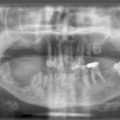Chapter 8). Maximum dose is deposited at the surface and the 90% dose level will be approximately 2 mm deep for a 60 kV beam up to 10 mm deep at 220 kV.
The field size may be defined by an applicator attached to the machine, but often a lead cut-out placed on the skin surface defines the field (this need only be 2 mm thick for beam energies up to 160 kV). The sharp penumbra in the high-dose isodoses means that the field can be matched to the PTV edge, although at depth there is some bowing out of the low value isodose contours. The dose deposited is significantly dependent upon the field size due to the contribution of scattered electrons within the patient. Although there is some variation of depth dose with field size, this tends to be pronounced beyond the clinically useful depths so will usually only be relevant if considering the dose to underlying structures. If a lead cut-out on the skin is used, the MU calculation must be based on the cut-out size as well as the applicator output. In this energy range, the electrons are more back and laterally scattered than for MV beams so the factors are referred to as back scatter factors (BSFs), which are the ratio of the dose in air in the absence of the patient to the dose in water at the patient surface (at the same location in the beam). The applicator output may be described by the ‘in air output’ or with the BSF included. To calculate the dose in a cut-out, the applicator output must be corrected by the ratio of the BSFs for the applicator and cut-out dimensions. This ratio is greater than unity, so that the MU required for the applicator are increased if a cut-out is used.
The ‘equivalent square’ of the cut-out needs to be calculated or, if tabulating the outputs of circular fields and back scatter factors, then the ‘equivalent diameter’ may be more appropriate as these areas tend to be more circular than rectangular. For irregular cut-outs and cut-outs on irregular contours, this area measurement is difficult and realistically the output may not be calculated to better than ±2–3% (and probably less accurate for the smallest fields) and may vary by more than this across the area of the cut-out due to the field shape, beam profile, and varying standoff.
Kilovoltage units have short source to skin distances of typically 20–50 cm SSD. Therefore, the inverse square law dependence of output is far more significant than for linac beams. For example, a 1 cm ‘standoff’ for a 25 cm SSD field results in a drop in output of 8%. It is therefore important to ensure optimum skin apposition to minimize the dose gradient across the PTV.
The limited applicator size means that fields may have to be abutted to treat long PTVs or for high curvature surfaces. The sharp penumbra means that fields can be abutted and give a uniform dose. The most practical method of achieving this is to use lead on the skin to define the junction rather than an applicator. Care should be taken to ensure the beams are as parallel to each other as possible to minimize overdosing at depth.
Stay updated, free articles. Join our Telegram channel

Full access? Get Clinical Tree




